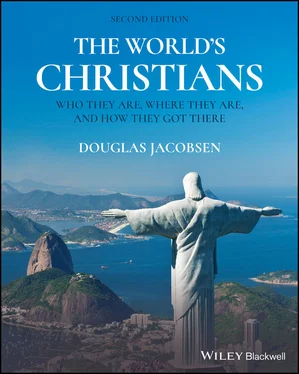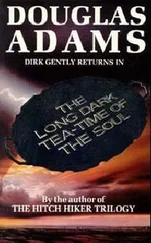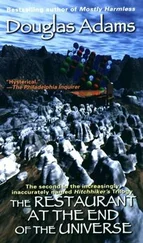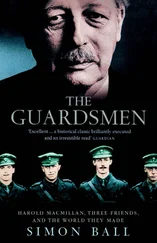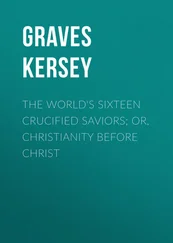| Table 3.1 |
Five main “families” of Protestantism, representing two thirds of all Protestants worldwide |
| Table 7.1 |
Major Muslim empires, indicating general attitude toward Christianity |
| Table III.1 |
Estimated number of individuals associated with the four Christian mega‐traditions in nine world regions |
| Table 10.1 |
Orthodox Christians in Eastern Europe |
| Table 10.2 |
Christianity in the Balkans |
| Table 10.3 |
Catholic Central Europe |
| Table 10.4 |
Christianity in the Russian sphere of influence |
| Table 12.1 |
Levels of religiosity in Catholic Europe by country |
| Table 12.2 |
Population size of Christian traditions in religiously mixed Europe |
| Table 13.1 |
Social and economic data for ten largest Sub‐Saharan African nations |
| Table 13.2 |
Changing size of four Christian traditions in Sub‐Saharan Africa, 1900 to present |
| Table 14.1 |
Distribution of three major world religions in East Asia |
| Table 16.1 |
The mainline Protestant denominations in the USA with membership data for 1950 and today |
Voices of World Christianity
1 1.1Vladimir Lossky on Orthodox Theology and Prayer
2 1.2Empress Theodora I and the Triumph of Orthodoxy
3 2.1John Henry Newman on the Pursuit of Truth
4 2.2Julian of Norwich on God’s Love for Humankind
5 3.1Fanny Crosby and Protestant Hymnody
6 3.2Martin Luther on Faith
7 4.1William J. Seymour on the Baptism with the Holy Spirit
8 4.2Kathryn Kuhlman on Health and Healing
9 5.1Thecla, An Early Christian Female Leader
10 5.2Augustine of Hippo on the Two Cities
11 6.1Patriarch Timothy I on Jesus and the Christian Life
12 6.2Brigid of Kildare in Pagan/Christian Ireland
13 7.1Catherine of Siena and the Pope
14 7.2Marco Polo Describes the Religious Policy of Kublai Khan
15 8.1David Yonggi Cho on “Rhema” Faith
16 8.2Walatta Petros defends Ethiopian Orthodoxy against European Catholicism
17 9.1Charles Malik on Truth and Public Life
18 9.2Hanan Ashrawi on Palestinian Christianity and the Spiritual Cost of Conflict
19 10.1Pope John Paul II on the Gospel and Poland
20 10.2Maria Alyokhina and the Pussy Riot Church Protest
21 11.1Paulos Mar Gregorios and the Principles of Interfaith Dialogue
22 11.2Pandita Ramabai’s Spiritual Journey
23 12.1Chiara Lubich and Focolare
24 12.2Dietrich Bonhoeffer and European Secularism
25 13.1Simon Kimbangu, a Congolese Christian Prophet
26 13.2Mercy Amba Oduyoye on Women, the Bible, and African Christianity
27 14.1Marianne Katoppo on Poverty, Women, and the Eucharist
28 14.2Pastor Wang Yi on the Relationship of Church and State
29 15.1Eva Peron’s Critique of the Catholic Church
30 15.2Gustavo Gutiérrez on Liberation Theology
31 16.1James Cone on Black and White Christianity
32 16.2Mother Angelica on the Left–Right Divide in American Catholicism
33 17.1Bernard Narokobi on Christianity and the Melanesian Way
34 17.2Bobbie Houston on The Sisterhood
Introduction to World Christianity
The Christian movement began with just a handful of people, maybe a few hundred, who had known Jesus while he was alive and who looked to him even after his death as their religious teacher and guide. Jesus was born in a remote part of Palestine at the eastern edge of the Roman Empire, and during his lifetime his following never extended beyond that region. Most of his closest associates were of modest means, and many – perhaps most – were illiterate. All in all, there was little to suggest that this movement would endure for centuries and someday span the globe. Yet today Christianity, the religion of Jesus, is the largest and most widely disseminated religion in the world.
There are many different ways to study religion, and there are many different ways to study the particular religion that is known as Christianity. Some scholars of Christianity spend most of their time and energy trying to understand Jesus himself, some focus on the distinctive beliefs and moral teachings of Jesus’s followers (theology), some concentrate their work on the oldest writings of Christianity (biblical studies), some want to know how Christianity has grown and developed over the centuries (the history of Christianity), and some emphasize the great works of art, architecture, and literature that have been produced by the Christian community. This book takes a multi‐disciplinary approach, combining historical, sociological, and theological resources, seeking to describe the vast diversity that now exists within the movement.
Christianity’s Global Diversity
Christianity appears in so many diverse forms around the world that some scholars have begun talking about Christianity in the plural, as Christianit ies that at times seem to have little in common. But that may be an overstatement. Yes, contemporary Christianity is amazingly complex, but Christianity has possessed an inner diversity from the very beginning. The willingness to allow a range of different interpretations to coexist side by side is part of Christianity’s religious ethos, and it is one of the reasons that Christianity has spread so widely around the world. Everywhere Christianity has gone it has adapted itself to local ideas, ideals, and practices. By the end of the first century the Christian movement already included Jews and Gentiles and people from all over north Africa, southern Europe, and the Middle East. These early Christians came from many different cultures, they spoke a variety of different languages, and they had distinct ways of thinking about their faith.
Diverse perspectives are evident in the foundational documents of the movement, within the pages of the New Testament itself. For example, the book of Galatians argues that “good works” have nothing at all to do with Christian faith or salvation, while the book of James argues that faith without “works” (proper moral conduct) is dead. The four New Testament gospels (attributed to Matthew, Mark, Luke, and John) present slightly different portraits of Jesus, but when the second‐century writer Tatian tried to harmonize those four gospels and turn them into one unified rendition of the life of Jesus, Christians rejected his text. They chose instead to maintain the four different versions of Jesus’s life that still appear in the Bible today.
The Christian movement was already diverse in the first and second centuries, and it has been diversifying ever since. As Christianity spread east into Asia, west into Europe, and south into Africa, each new tribe, nation, or linguistic unit that embraced the faith of Jesus added its own ideas and emphases to the movement, and this process of growth and transformation has accelerated in the last two centuries.
Today Christianity is the most culturally and ethnically diverse religion that has ever existed in human history. Christians live in every nation on earth, and they bring insights from all the world’s cultures into their understandings of faith. Roughly 25 percent of the world’s Christians now live in Europe, another 25 percent live in Africa, 25 percent in Latin America, 15 percent in Asia, and 10 percent reside in North America. (These population percentages are obviously rounded estimates. More precise numbers appear in the remainder of this book, and the process for obtaining those numbers is explained in the appendix on “Counting Christians.”) This relatively even distribution of the Christian population around the world represents a far greater global dispersion of faith than is characteristic of the other three major world religions of Islam, Hinduism, and Buddhism. More than 95 percent of today’s Hindus and Buddhists live in Asia, and Asia is also home to almost three‐quarters of the world’s Muslims.
Читать дальше
